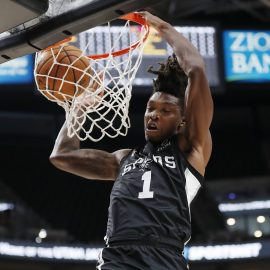Every morning, we compile the links of the day and dump them here… highlighting the big story line. Because there’s nothing quite as satisfying as a good morning dump.
Boston Celtics big man Daniel Theis is out indefinitely with a tear in his right plantar fascia, suffered against the Detroit Pistons on Saturday.
…
“He’s out indefinitely, but the indefinite timeline sounds worse than the timeline we’ve been given,” Stevens said. “I think it’s not going to be season-derailing or anything like that. Hopefully we’ll see how he progresses over the next few weeks. Then the next steps will be determined. But they think it will be pretty quick recovery, which is fortunate.”
Aron Baynes has been missing time as well with a hamstring injury. He said he’s nearing 100 percent again, which could be important as the Celtics look to fill a void at center. Rookie Robert Williams may also have extended opportunities.
The plantar fascia is a pretty important piece of your foot, seeing how it connects your toes to your heel and basically defines the shape of your arch.
The fascia is stretched by running and jumping, so it’s no surprise that plantar fasciitis is often seen in basketball. Extended bouts of plantar fasciitis can lead to bone spurs in the heel: as a protective measure in response to repeated injuries, the attachment point of the plantar fascia will ossify to prevent further damage. If a player has surgery to remove bone spurs in their heel, odds are it’s due to untreated plantar fasciitis or repeated ankle injuries.
An aspect of being tall that receives comparatively little attention–in part because it requires mathematics–is that as you get larger, the volume of your body increases more rapidly than the surface area of the various load-bearing bones and connective tissue.* This means that, as weight and height increase, the load on the bones and connective tissue increases disproportionately. A 7′-0″ tall player weighing 270lbs is not putting the same amount of stress on his bones and connective tissue, per square inch of surface area, as a player who is, say, 6′-0″ and 180, he’s actually putting something closer to a third more stress per square inch.
Couple that increased load with the stresses of playing competitive basketball, and guys who would be perfectly healthy otherwise, are going to have all sorts of issues with their legs–they’re not just pushing against the body’s limits in terms of physical activity, they’re pushing against the body’s limits in terms of size as well.
Illustrated with examples: This is why elephants, rhinoceroses and hippopotamuses have extremely thick legs, and why the largest animals ever to live are found in oceans, where bones do not need to support 100% of the body’s weight.
Anyway, that’s today’s lesson in anatomy, sports medicine and mathematics.
As it applies to Theis? It’s a bit discouraging to see Daniel suffer another connective tissue injury so soon after a partial meniscus tear–and after nursing what was likely another soft tissue injury in his other foot over the past few weeks. I wonder if he’s going to be plagued with connective tissue problems throughout his career.
As it relates to the Celtics depth, according to the same MassLive article, Aron Baynes is allegedly close to 100%, and the Celtics have a rookie from another planet who would benefit from some early season minutes.
*How volume and surface area scaling work with cubes: A 1″ square cube has a surface area of one square inch and a volume of one cubic inch. If you double the length of the sides of the square to 2″, the area of each side of the cube quadruples, from one square inch to four square inches, while the volume of the cube goes from one to eight cubic inches. If you fill the cube with water, a one square inch cube supports the weight of one cubic inch on one square inch. However, if you double the length of the sides of the cube, you have eight cubic inches of water supported by four square inches of surface area–twice as much water is being carried by each square inch; triple the length and the load per square inch triples, and so on and so forth. Because the human body isn’t a cube, load scaling doesn’t work quite this neatly–for information about how scaling works, your best reference is literature on the BMI.
Page 2: Where what if the Celtics’ slump is officially ‘over’?
Boston (4-2) beat an undefeated Detroit team, on the Pistons’ home floor, by 20 points.
That’s no big deal, especially this early in the season.
But Boston won with the game with their top two scorers (Jayson Tatum and Kyrie Irving) tallying a COMBINED nine points.
The Celtics’ best stretch big Al Horford missed all five of his three-point attempts.
John posted a link to this article in yesterday’s dump. If you’ve already read it, skip on to the “rest of the links”, which is going to be pretty boring, because not much happened yesterday.
I want to take a deeper dive into it because there’s an interesting similarity between the Celtics’ first win and this most recent one: In both games, big name players had crappy nights. Irving couldn’t hit the broad side of a barn against Philly–and he wasn’t any better against the Pistons. In the first game, Hayward struggled, and against Detroit, it was Tatum.
But the Celtics won both of those games going away–because the ball didn’t stick with the players who were ice cold. During the interim, the Celtics had a string of games where guys were pressing, were trying to get their individual games back on track, thinking that was the best way to help the team. However, this team is so deep that if one guy’s having a bad night, odds are someone else will have a good night if they just get enough touches, and the team plays so much better when they keep the ball moving.
The league’s defenses are, collectively, so focused on stopping individuals, and you can throw a pass a lot faster than guys can move, that a team running a good motion offense can usually get someone a good look eventually. The key is making that next pass. When the Celtics are relaxed and not focused on their own individual struggles, they’re going to be good enough to beat any team in the league. However, if each guy’s trying to break out of his own slump and thinking that getting out of that slump is the best way he can help the team, it’s not going to work.
The rest of the links:
Boston Herald: Celtics notebook: Team optimistic about Daniel Theis’ recovery
NBC Sports: Theis out indefinitely with foot injury | Irving and Tatum play 1-on-1 after practice
Boston.com: The injury plague has hit the Celtics — again
Add The Sports Daily to your Google News Feed!






